
Finders Seekers is a monthly puzzle subscription box for anyone who loves puzzles, escape rooms, Sherlock Holmes, mysteries, or anything requiring a little brainpower. Finders Seekers features a new destination each month, so in addition to the puzzle/escape room experience, you get a mini travel experience, too, exploring a new city and its culture every month.
DEAL: Save $5 on your first box! Use this link and coupon code BRAINQUEST.
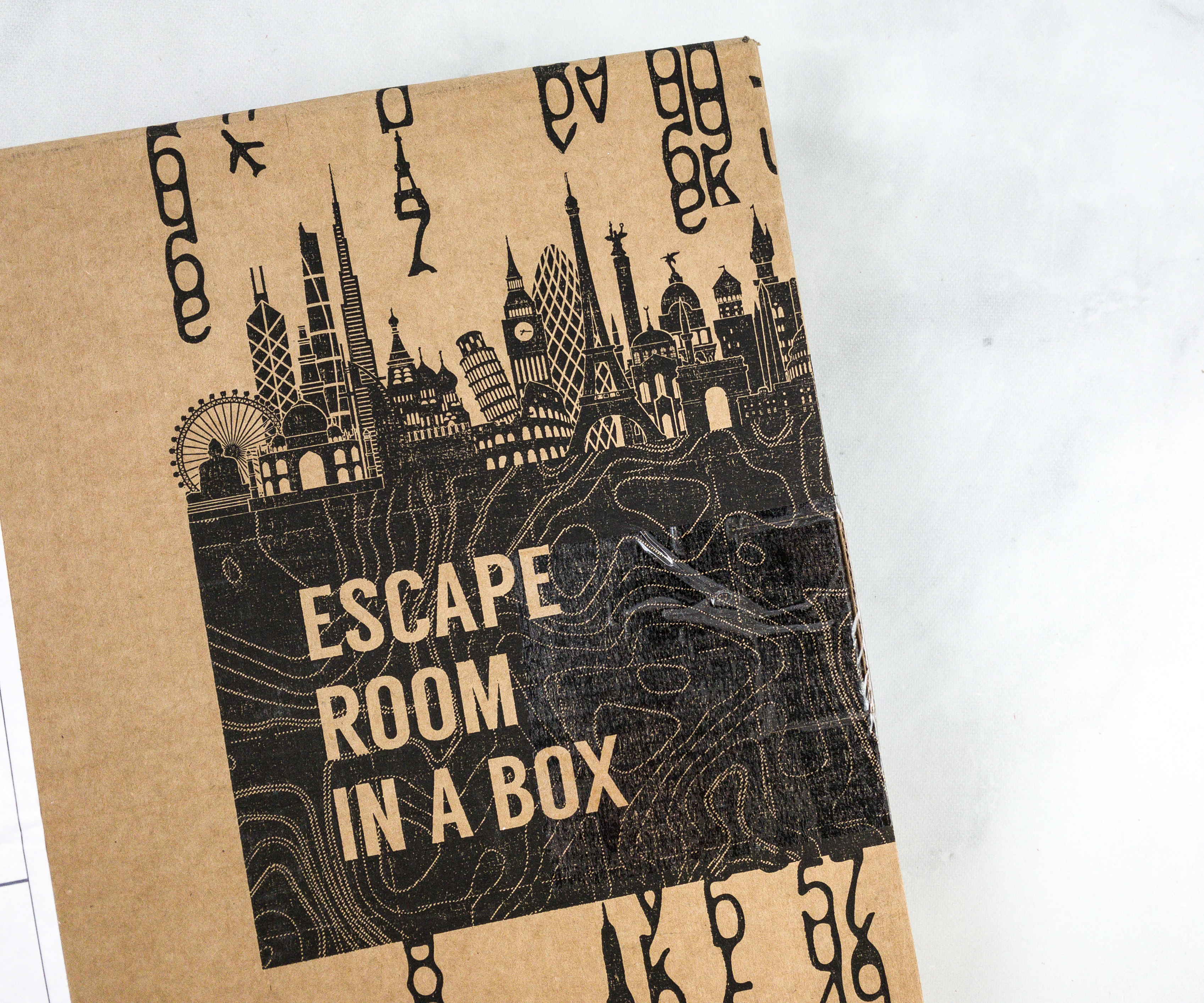
FYI – there are SPOILERS in this post!

As a subscriber (limited numbers can join each month), you are invited to join the Society of Seekers, a group of like-minded puzzle fiends who use their heads and a little bit of internet-search know-how to explore a city and solve a mystery each month. We’re off to BEIJING this month!

Everything is packed in a string-tie envelope.

There’s also a sticky note that contains instructions on how to get started with this case.

Everything in the box!

Included in this month’s box is a welcome letter and checklist of every item that should be inside the package, plus all the clues we’ll need to solve the mystery.
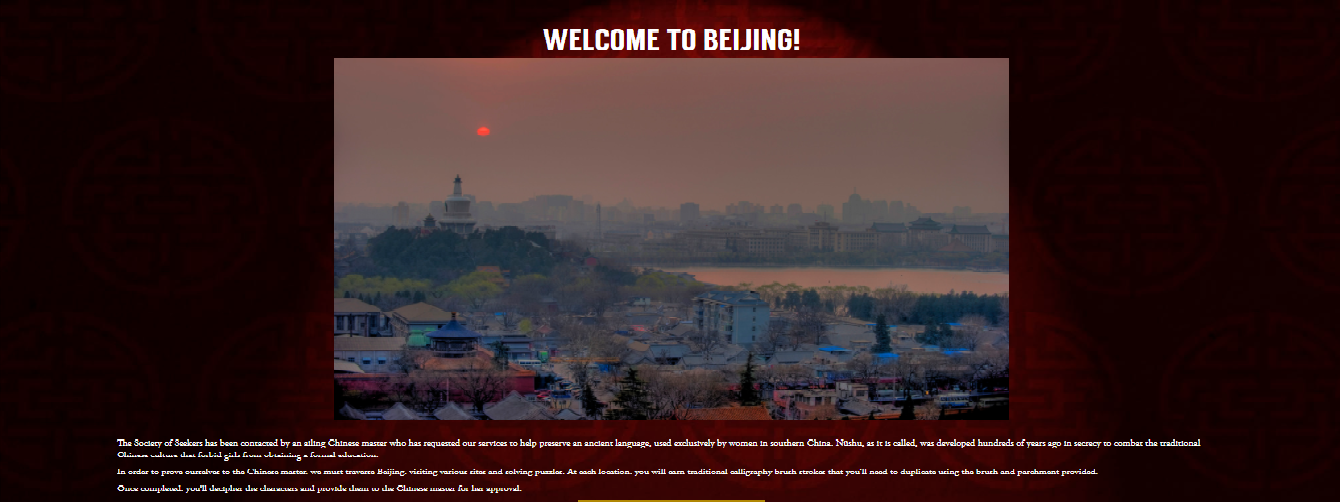
The website took us to Beijing, China!
The Society of Seekers has been contacted by an ailing Chinese master who has requested our services to help preserve an ancient language, used exclusively by women in southern China. Nüshu, as it is called, was developed hundreds of years ago in secrecy to combat the traditional Chinese culture that forbid girls from obtaining a formal education.
In order to prove ourselves to the Chinese master, we must traverse Beijing, visiting various sites and solving puzzles. At each location, you will earn traditional calligraphy brush strokes that you’ll need to duplicate using the brush and parchment provided.
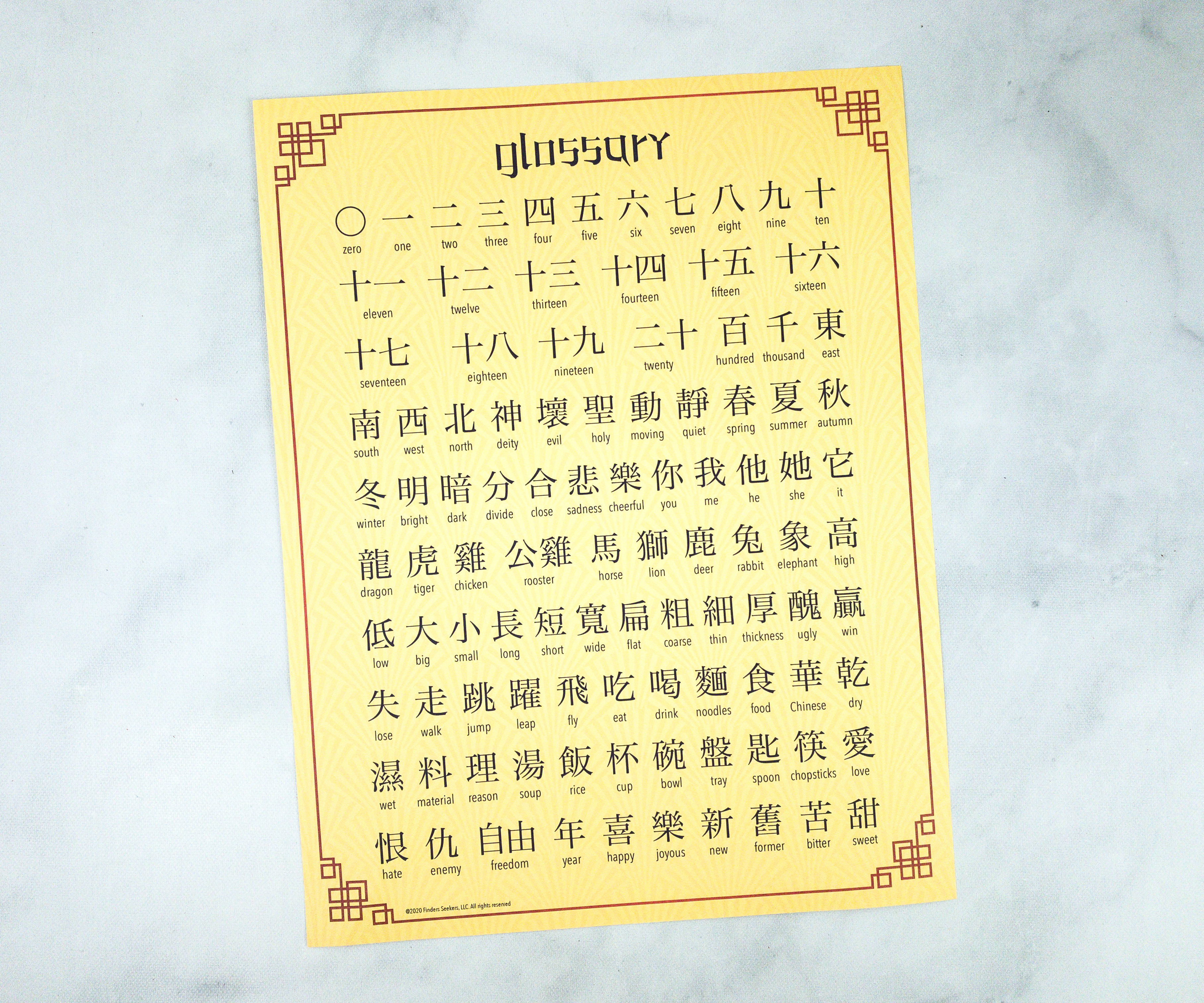
Chinese Characters Glossary. Since this mission is all about China, they sent us a glossary which can be used as a reference to translate Chinese characters we’ll encounter into English.

There are more words are at the back of the paper.

First stop is The Temple Of Heaven Park. For this, we need to decipher the Chinese characters at the back of a scroll to earn our first stroke!
The Temple of Heaven park is massive. There are gorgeous buildings throughout the grounds including the iconic Hall of Prayer for Good Harvests, built in the 1400s. It was here that for centuries, the Emperor of China would visit each year, abstaining from meat, to pray for healthy crops. As you enter the main temple, admiring the 12 pillars representing the months each year, you are handed a red scroll with a proverb on it. This is your first puzzle. You must decipher a passphrase to earn a set of calligraphy brush strokes.

Temple of Heaven Scroll. The scroll has wise words written in front.
listening well, is as powerful as talking well, and is also as essential to the conversation.

At the back, there are Chinese characters that we need to identify. This is where the glossary will come in handy!
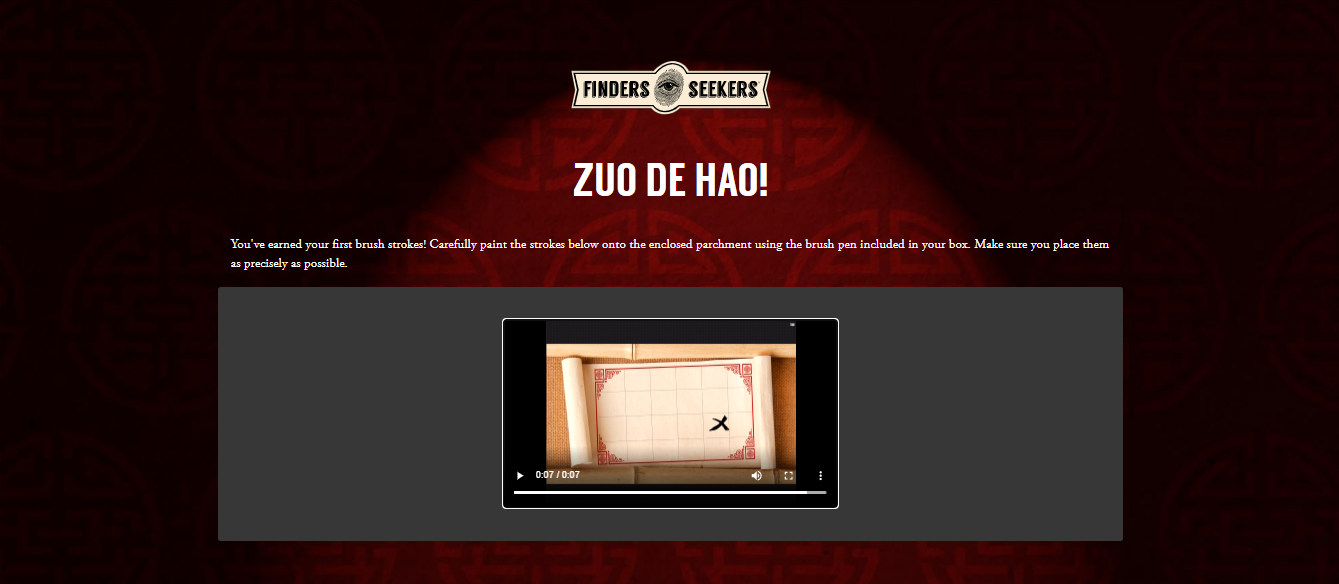
We earned our first stroke!
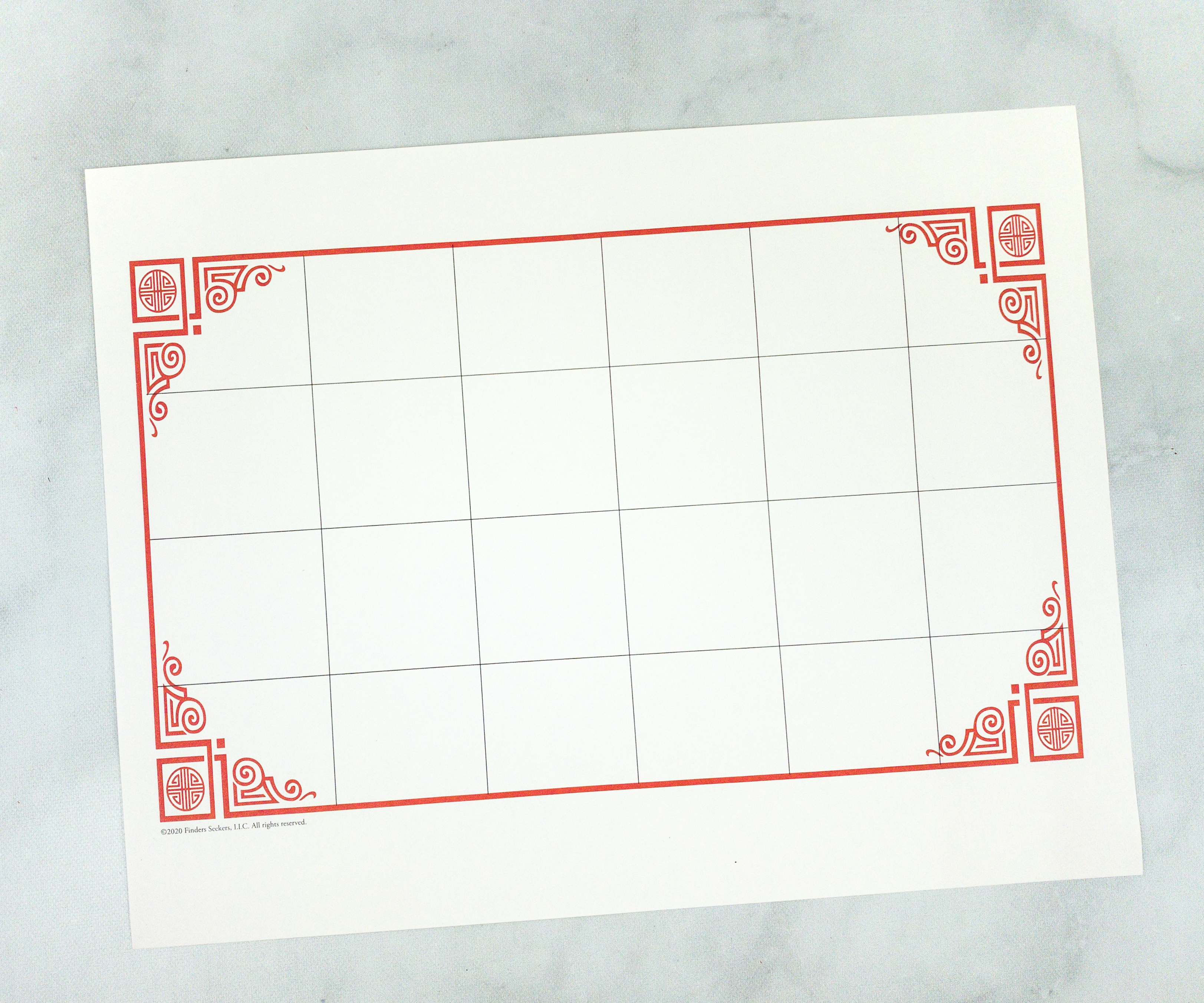
Calligraphy Parchment Paper. The box provided us a piece of parchment paper where we can write each stroke until we form the final character.

Watercolor Brush Pen. Of course, there’s also a brush pen for writing!

Next, we move on to the Great Wall of China!
Just a short drive to the northwest of Beijing in the mountain ridge of Xizhazi Village is a great remnant of the Great Wall that traverses steep climbs. Beginning in the 7th century BC, a series of fortifications and walls were built to protect the Chinese empire from attackers. The majority of the existing wall was completed during the Ming Dynasty (1368 – 1644).
As you begin your ascent, you quickly notice how steep the stairs are and how shallow the tread is. From centuries of use, the stairs bow in the middle and you really struggle climbing them. Then, you see others climbing the stairs in the proper manner: sideways!
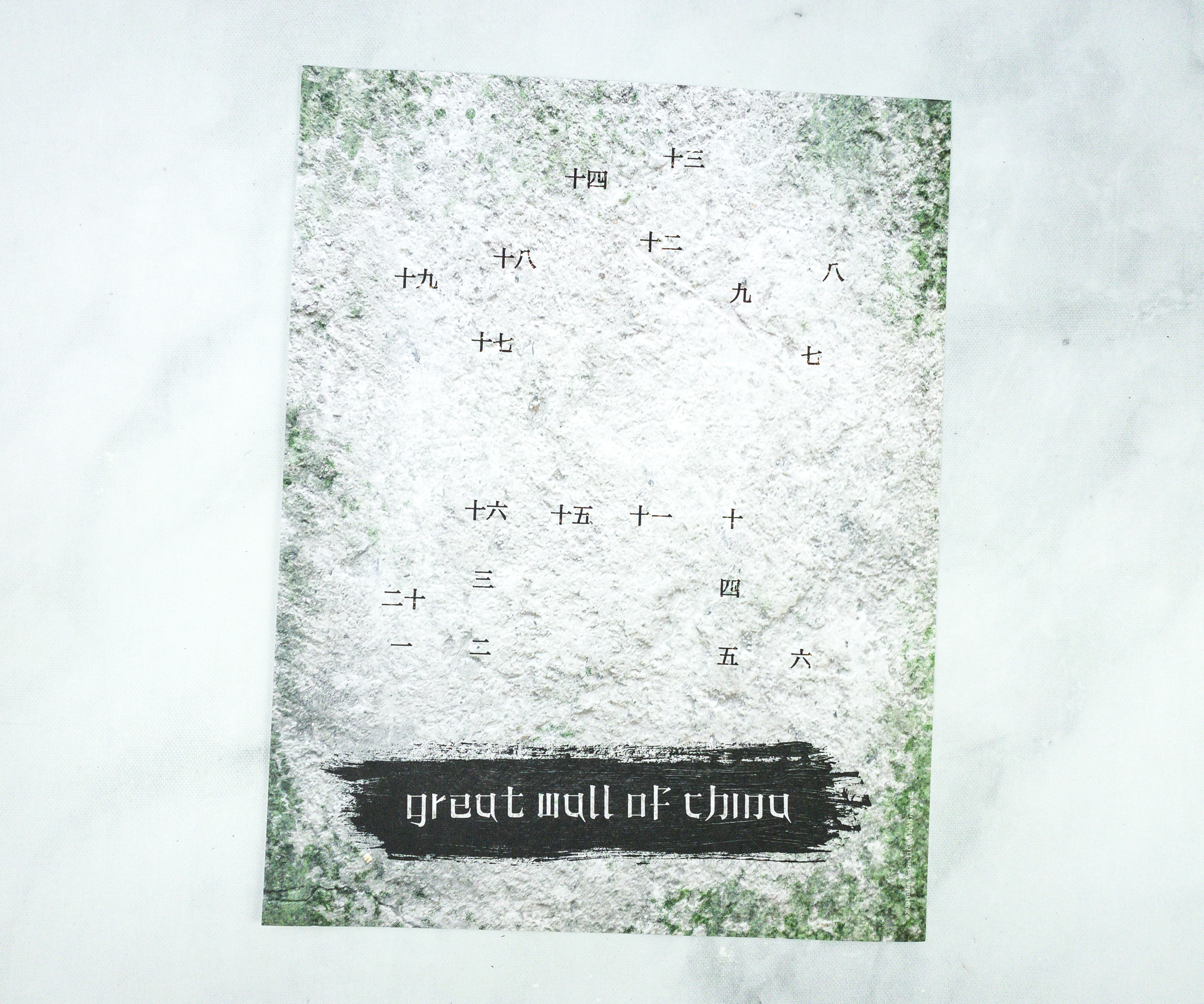
Great Wall Puzzle. For this part of the mission, we just need to connect the dots on the puzzle to find the hidden word!
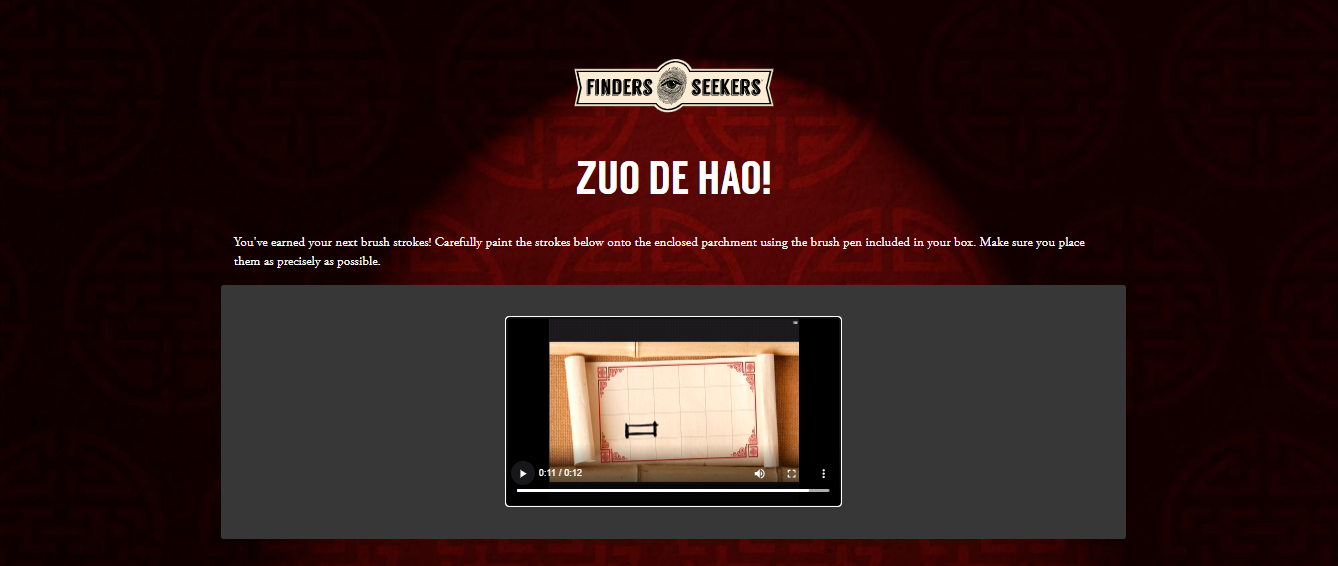
We now have our next brush stroke!
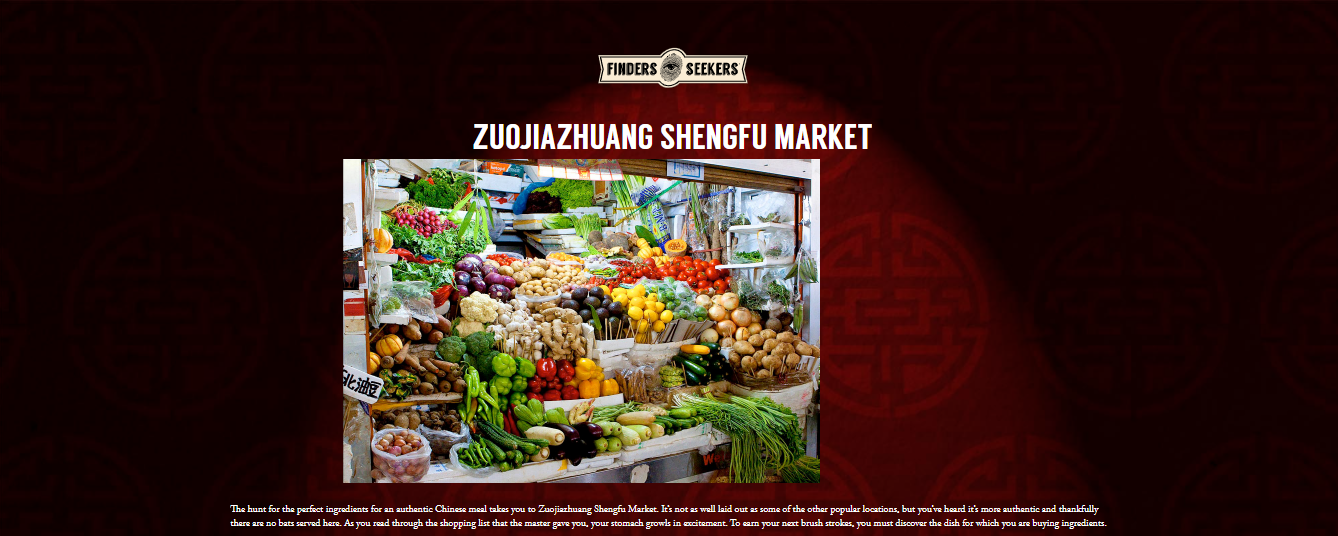
We then proceeded to Zuojiazhuang Shengfu Market!
The hunt for the perfect ingredients for an authentic Chinese meal takes you to Zuojiazhuang Shengfu Market. It’s not as well laid out as some of the other popular locations, but you’ve heard it’s more authentic and thankfully there are no bats served here. As you read through the shopping list that the master gave you, your stomach growls in excitement. To earn your next brush strokes, you must discover the dish for which you are buying ingredients.

Market Shopping List. This shopping list is the next clue and what we’ve noticed on it is that there are blurred out by liquid droplets!
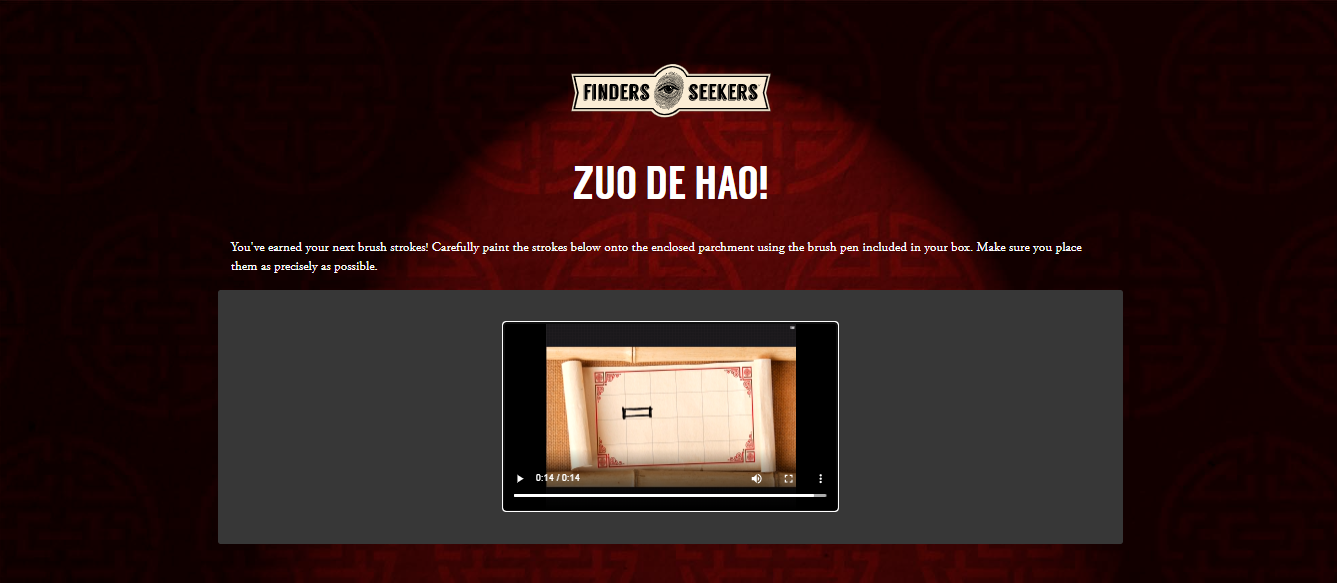
When we figured out the word from the shopping list, they provided us with the third brush stroke!
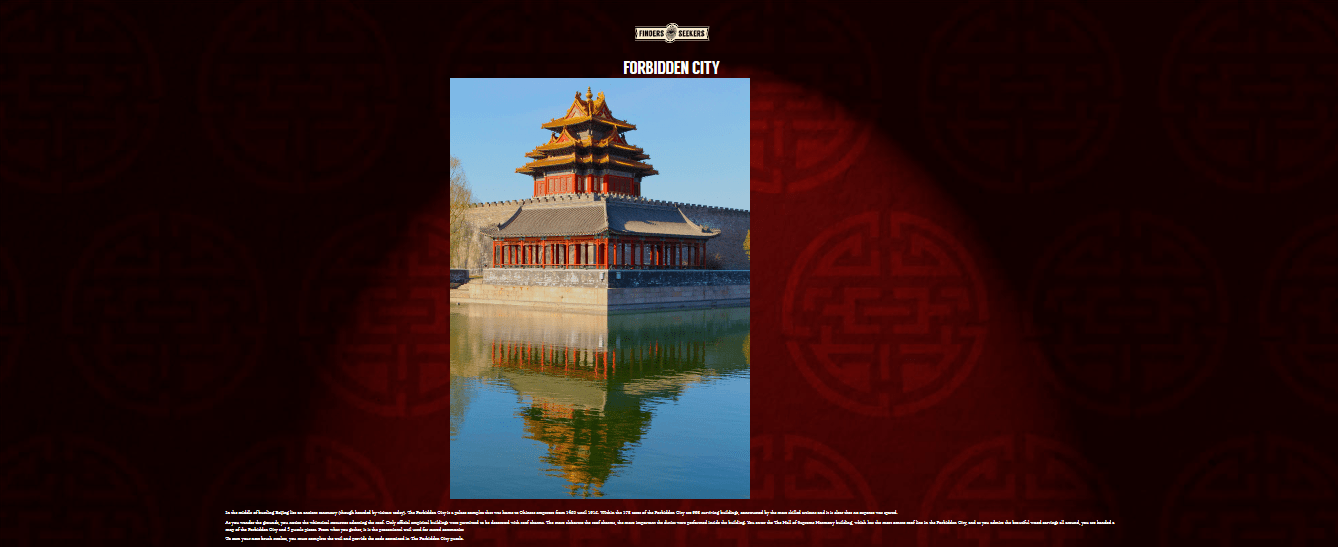
It’s time to visit the Forbidden City!
In the middle of bustling Beijing lies an ancient sanctuary (though hoarded by visitors today). The Forbidden City is a palace complex that was home to Chinese emperors from 1420 until 1912. Within the 178 acres of the Forbidden City are 998 surviving buildings, constructed by the most skilled artisans and it is clear that no expense was spared.
As you wander the grounds, you notice the whimsical statuettes adorning the roof. Only official empirical buildings were permitted to be decorated with roof charms. The more elaborate the roof charms, the more important the duties were performed inside the building. You enter the The Hall of Supreme Harmony building, which has the most ornate roof line in the Forbidden City, and as you admire the beautiful wood carvings all around, you are handed a map of the Forbidden City and 5 puzzle pieces. From what you gather, it is the processional trail used for sacred ceremonies.
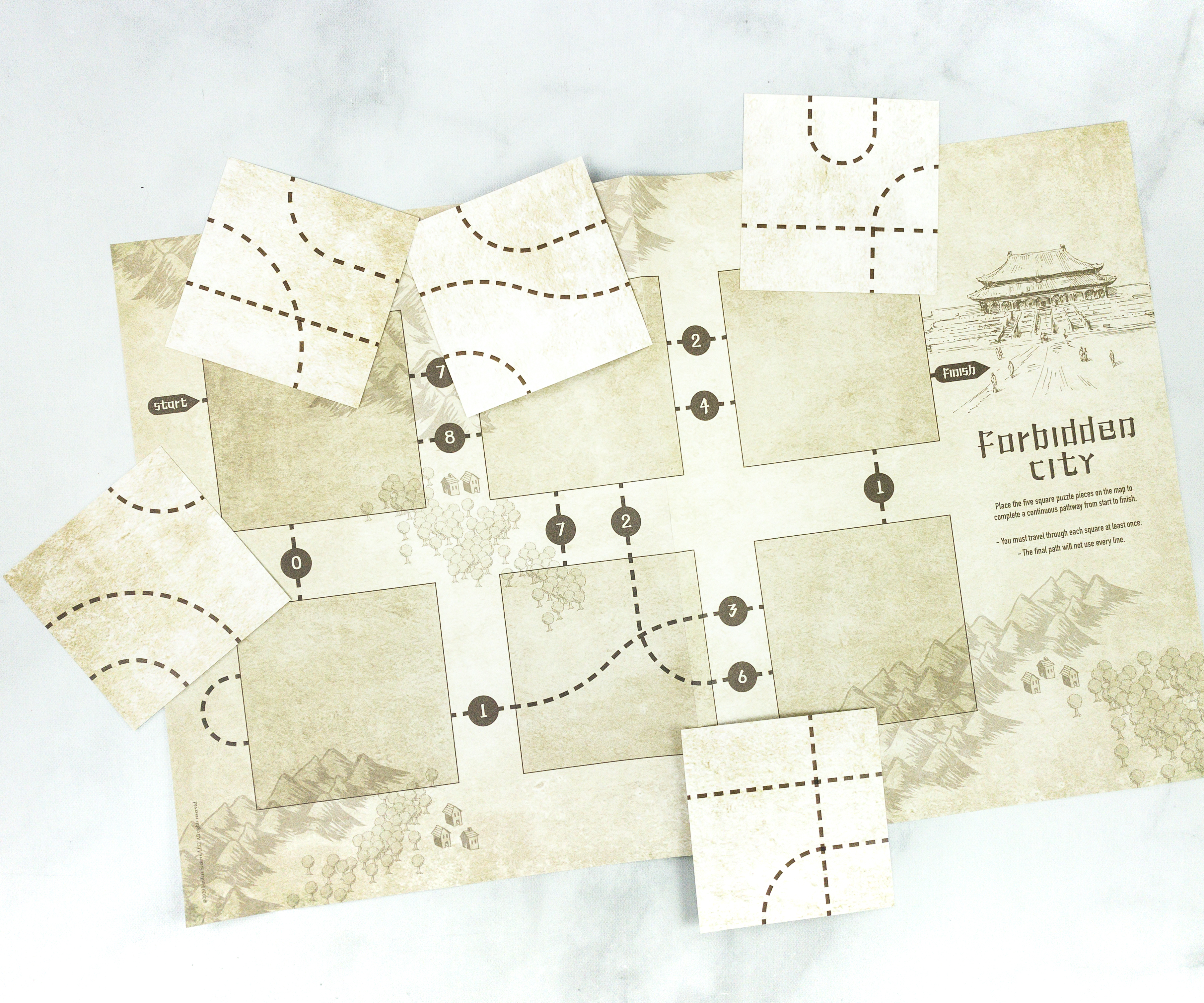
Forbidden City Puzzle. To earn our next brushstroke, there’s a puzzle where we need to arrange the squares to create the correct trail. It was a bit tricky with the lines but we still got the correct sequence!
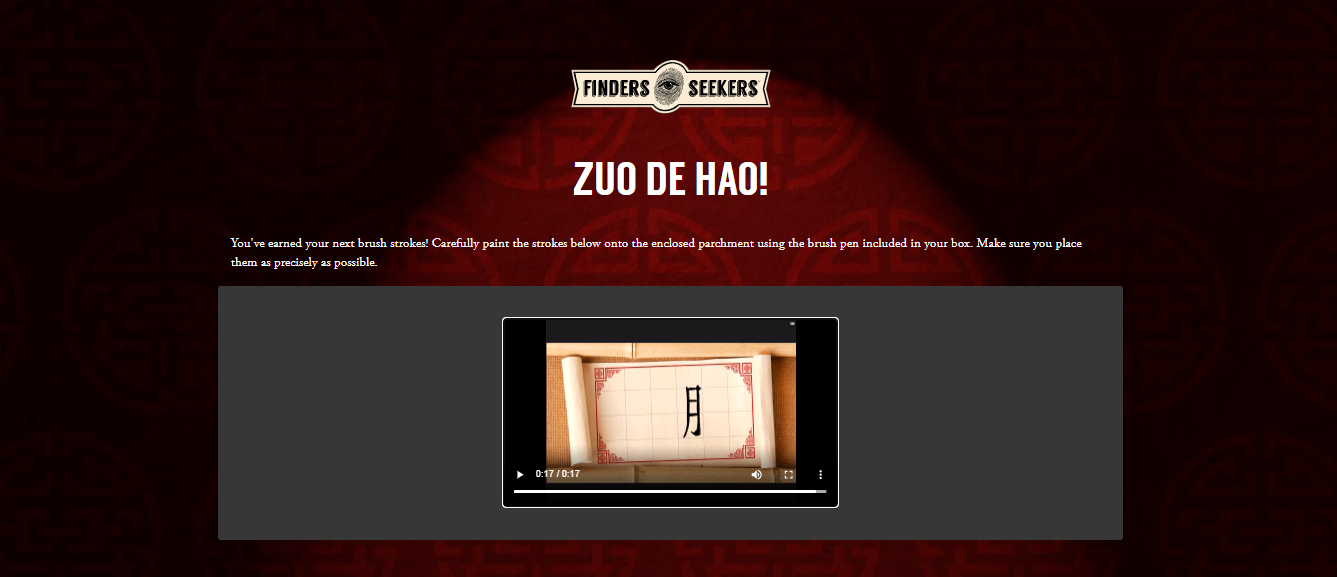
The puzzle provided us with our fourth stroke!
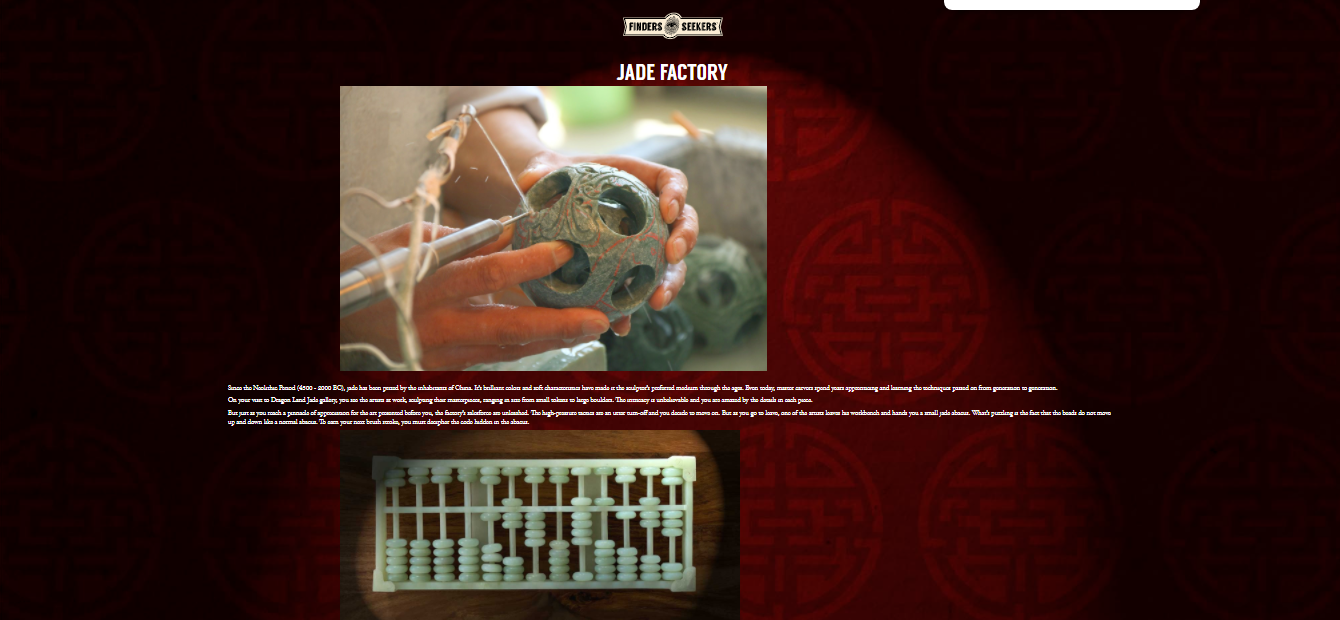
The next location is the Jade Factory!
Since the Neolithic Period (4500 – 2000 BC), jade has been prized by the inhabitants of China. It’s brilliant colors and soft characteristics have made it the sculptor’s preferred medium through the ages. Even today, master carvers spend years apprenticing and learning the techniques passed on from generation to generation.
On your visit to Dragon Land Jade gallery, you see the artists at work, sculpting their masterpieces, ranging in size from small tokens to large boulders. The intricacy is unbelievable and you are amazed by the details in each piece.
But just as you reach a pinnacle of appreciation for the art presented before you, the factory’s salesforce are unleashed. The high-pressure tactics are an utter turn-off and you decide to move on. But as you go to leave, one of the artists leaves his workbench and hands you a small jade abacus. What’s puzzling is the fact that the beads do not move up and down like a normal abacus.
With the abacus on the photo, we are not able to move the beads up or down. We just need to find the corresponding numbers with their arrangement.

We got another set of strokes upon completing the abacus puzzle!
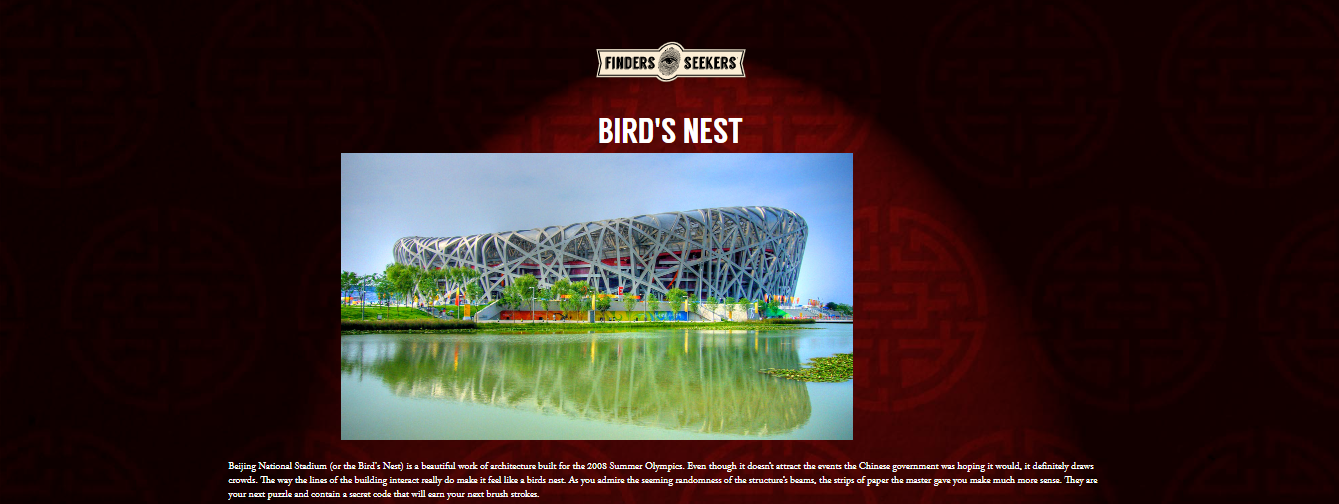
We’re getting closer to the final character. Next up is Bird’s Nest!
Beijing National Stadium (or the Bird’s Nest) is a beautiful work of architecture built for the 2008 Summer Olympics. Even though it doesn’t attract the events the Chinese government was hoping it would, it definitely draws crowds. The way the lines of the building interact really do make it feel like a birds nest. As you admire the seeming randomness of the structure’s beams, the strips of paper the master gave you make much more sense.
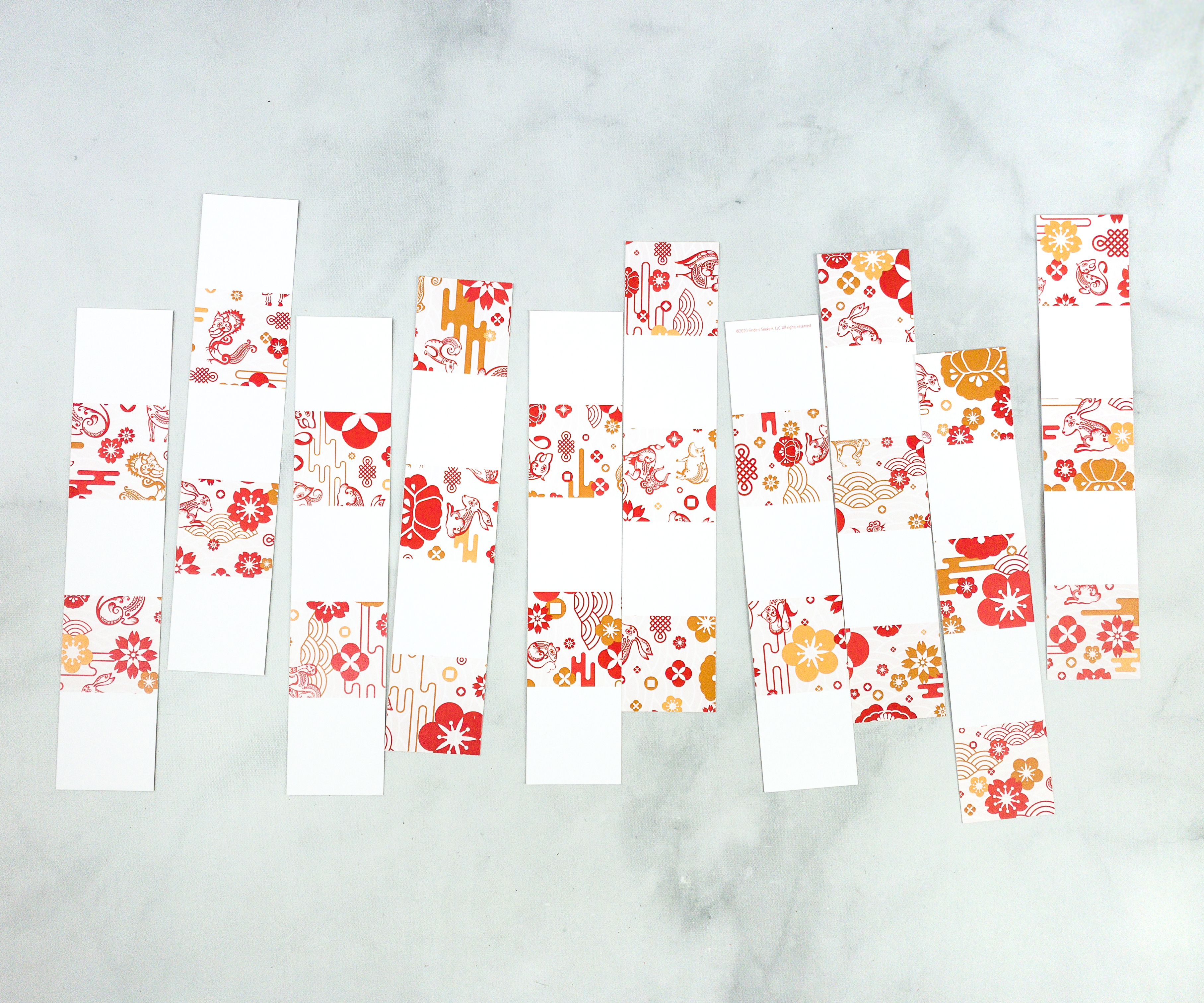
Paper strips. Using these strips of papers and some weaving skills, we were able to acquire the next hidden message! The front of the strips has some flower prints on it.
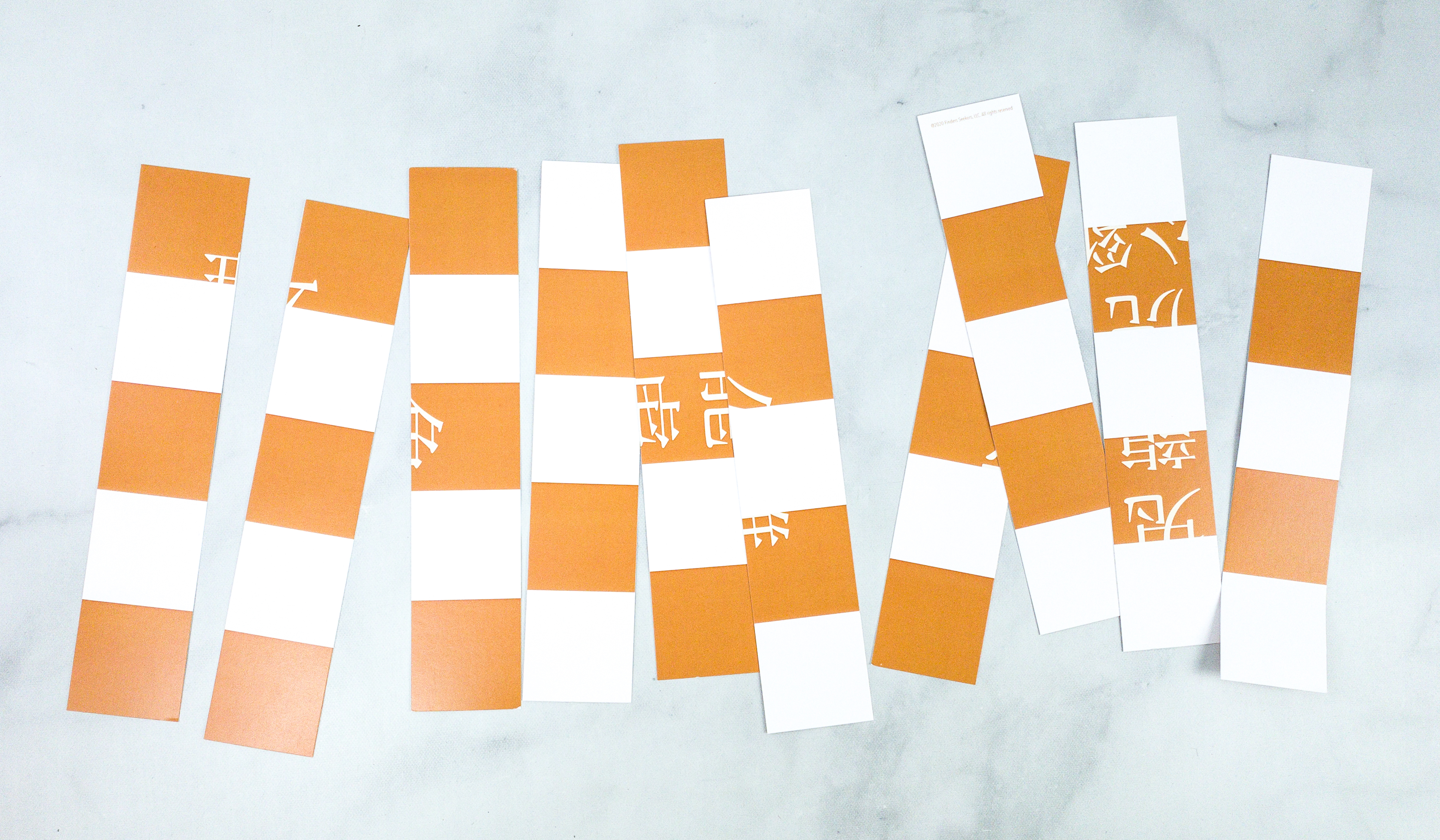
At the back, it looks like there are hidden Chinese characters. After a number of tries, we finally got the correct arrangement that gave us our set of characters!
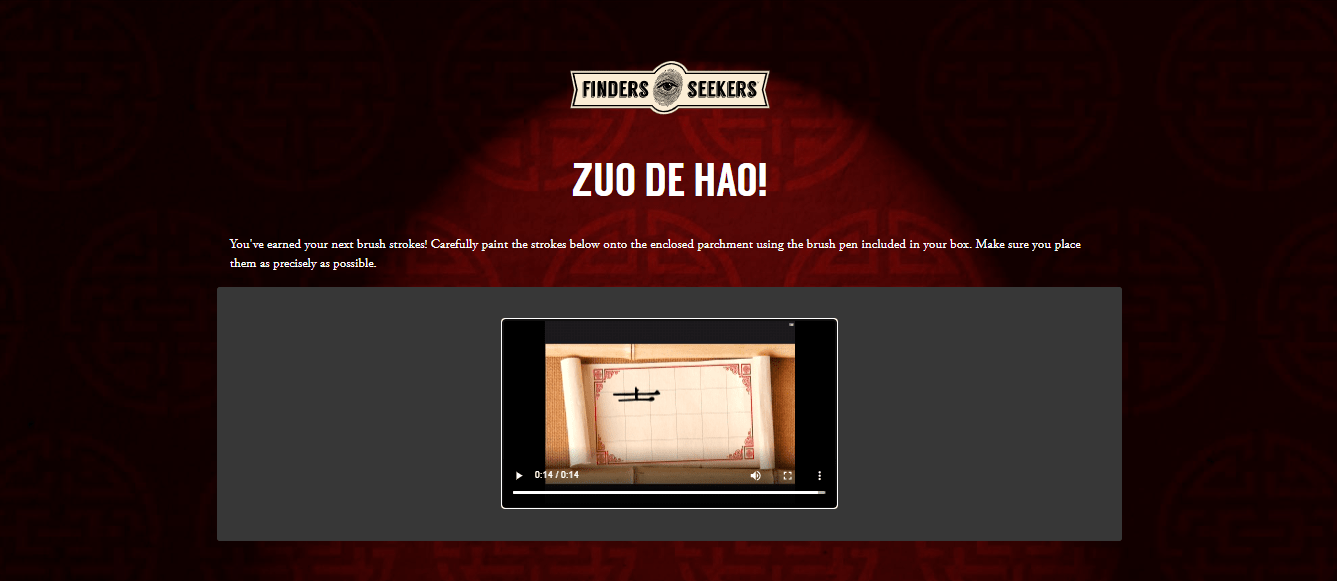
The puzzle rewarded us with our next set of brush strokes!

Now, we visit the Lao She Teahouse!
You’re enjoying a traditional tea performance at the Lao She Teahouse! Good thing you booked this one ahead of time… The tables and decor make the place feel so ancient, almost museum-like. As the performer finishes her tea dance you look down at your cup and notice a strange inscription in the bottom of your teacup. Intrigued you snap a picture to share with your friends later.
We noticed that there are words on our tea. We tried reading them backward to find the answer!
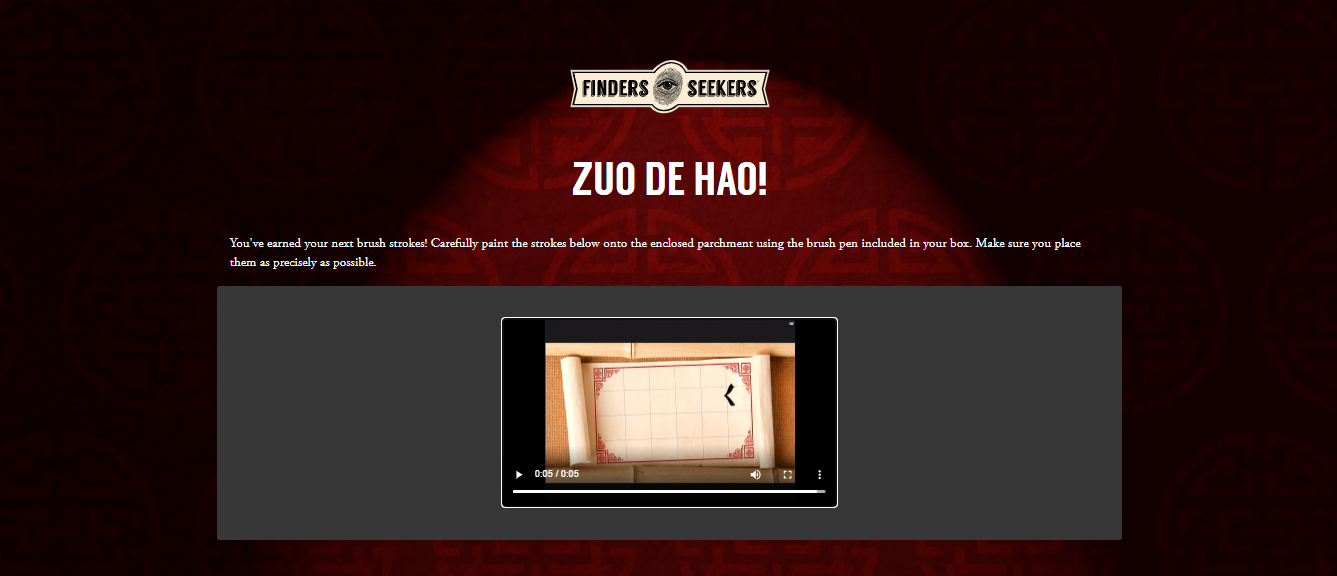
These Eight Immortals gave us another set of brush strokes!
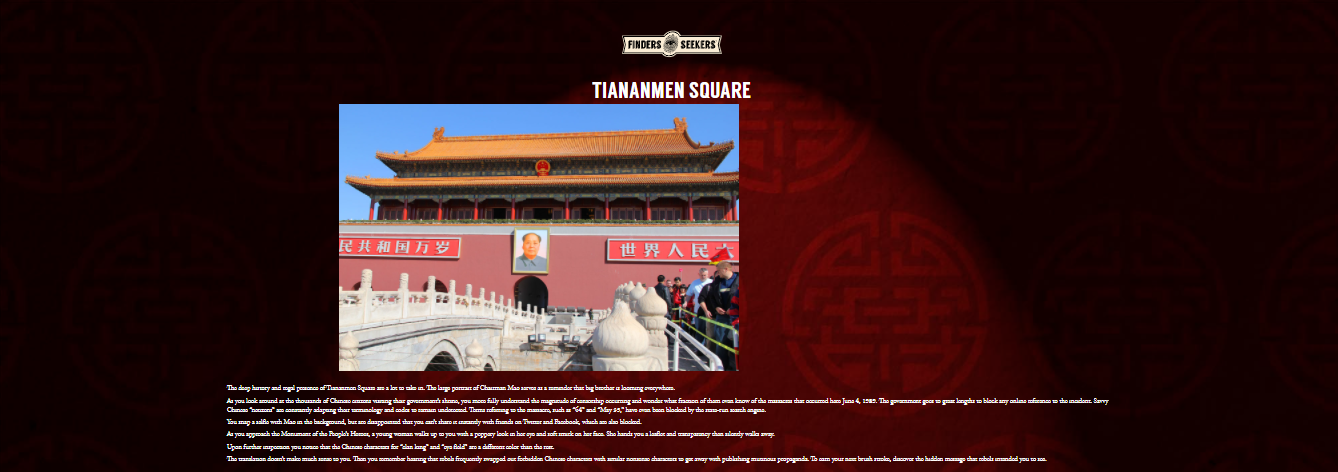
We then proceeded to Tiananmen Square!
The deep history and regal presence of Tiananmen Square are a lot to take in. The large portrait of Chairman Mao serves as a reminder that big brother is looming everywhere.
As you look around at the thousands of Chinese citizens visiting their government’s shrine, you more fully understand the magnitude of censorship occurring and wonder what fraction of them even know of the massacres that occurred here June 4, 1989. The government goes to great lengths to block any online reference to the incident. Savvy Chinese “netizens” are constantly adapting their terminology and codes to remain undetected. Terms referring to the massacre, such as “64” and “May 35,” have even been blocked by the state-run search engine.
You snap a selfie with Mao in the background, but are disappointed that you can’t share it instantly with friends on Twitter and Facebook, which are also blocked.
As you approach the Monument of the People’s Heroes, a young woman walks up to you with a peppery look in her eye and soft smirk on her face. She hands you a leaflet and transparency then silently walks away.
Upon further inspection you notice that the Chinese characters for “clan king” and “eye field” are a different color than the rest.
The translation doesn’t make much sense to you. Then you remember hearing that rebels frequently swapped out forbidden Chinese characters with similar nonsense characters to get away with publishing mutinous propaganda.

Political Flyer. This flyer is one of our key tools in solving this next puzzle. It has an image of a man whose chain cuffs are broken.
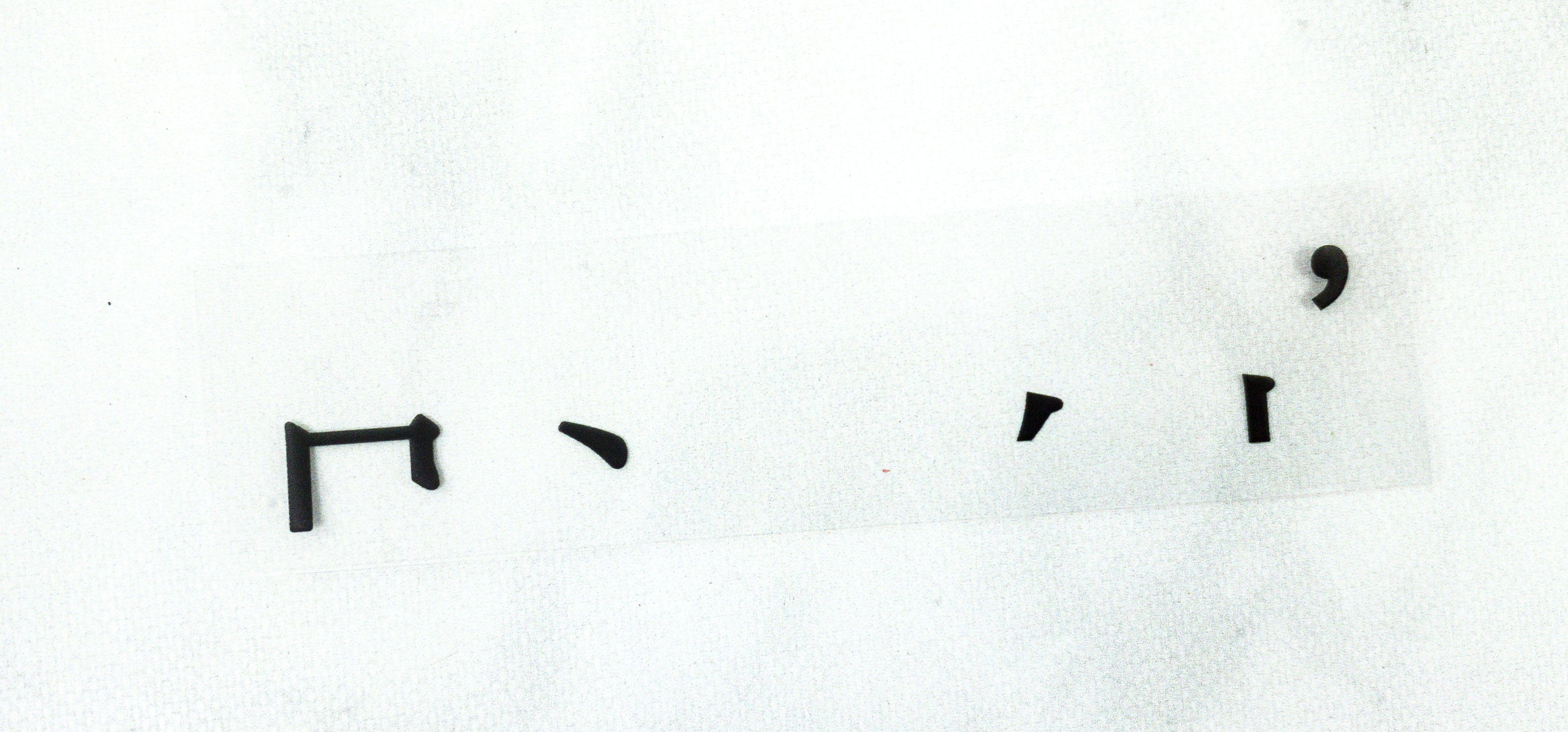
Transparency. We just need to put the transparent sheet on top of the characters of the political flyer and check the glossary to make sense of the words!

A new set of brush strokes are unlocked upon completing the puzzle from Tiananmen Square!

We also visited the Lama Temple!
After several days in the bustle of Beijing’s industrial center, you decide to try to find some peace and serenity by visiting Yonghe Temple, or more popularly known as the Lama Temple. Construction began on the temple in 1694. For centuries, it was a monastery that housed Tibetan Buddhist monks. Today, it is a national monument that is also a functioning temple.
As you explore the peaceful grounds, you happen upon the very ornate and beautiful statue of Tsongkhapa. As you read about his meticulous steps on the path to sutra and tantra, you are approached by one of the monks. He motions to 5 differently colored doors you hadn’t noticed behind the grand statue and tells you that one of the doors leads to eternal wisdom and your next brush stroke. He then hands you a handwritten note that reads:
-
THE BLUE DOOR IS TWO DOORS AWAY FROM THE DOOR TO ETERNAL WISDOM.
-
THE RED DOOR IS AT THE FAR RIGHT, AND IS TWO DOORS AWAY FROM THE BLUE DOOR.
-
THE PURPLE DOOR IS NOT NEXT TO THE DOOR TO ETERNAL WISDOM.
-
THE GREEN DOOR IS LEFT OF THE BLUE DOOR.
-
THE ORANGE DOOR IS NOT NEXT TO THE RED OR BLUE DOORS.
With all the clues, we shouldn’t have any problem solving this puzzle. After analyzing the note, we got the correct color sequence which is ORANGE, GREEN, BLUE, PURPLE, and RED!

The doors led us to our next set of brush strokes!

Up next is the Silk Factory!
After visiting the Lama Temple, your tour bus takes you to the Dong Wu silk museum and factory.
Silk was first produced in China, beginning at least 8,500 years ago. This luxury textile is lightweight, yet very strong and durable. The guide demonstrates the many stages of creating silk, from farming the silk larvae to weaving on large looms and then the intricate dyeing process.
At the end of the tour (and after the obligatory high-pressured sales pitch of overpriced merchandise), one of the factory workers hands you a silk fan. To earn your next brush stroke, you must discover the fan’s hidden passcode.

Chinese Silk Fan. We received a silk fan that we need to decode in order to gain our next brush stroke.
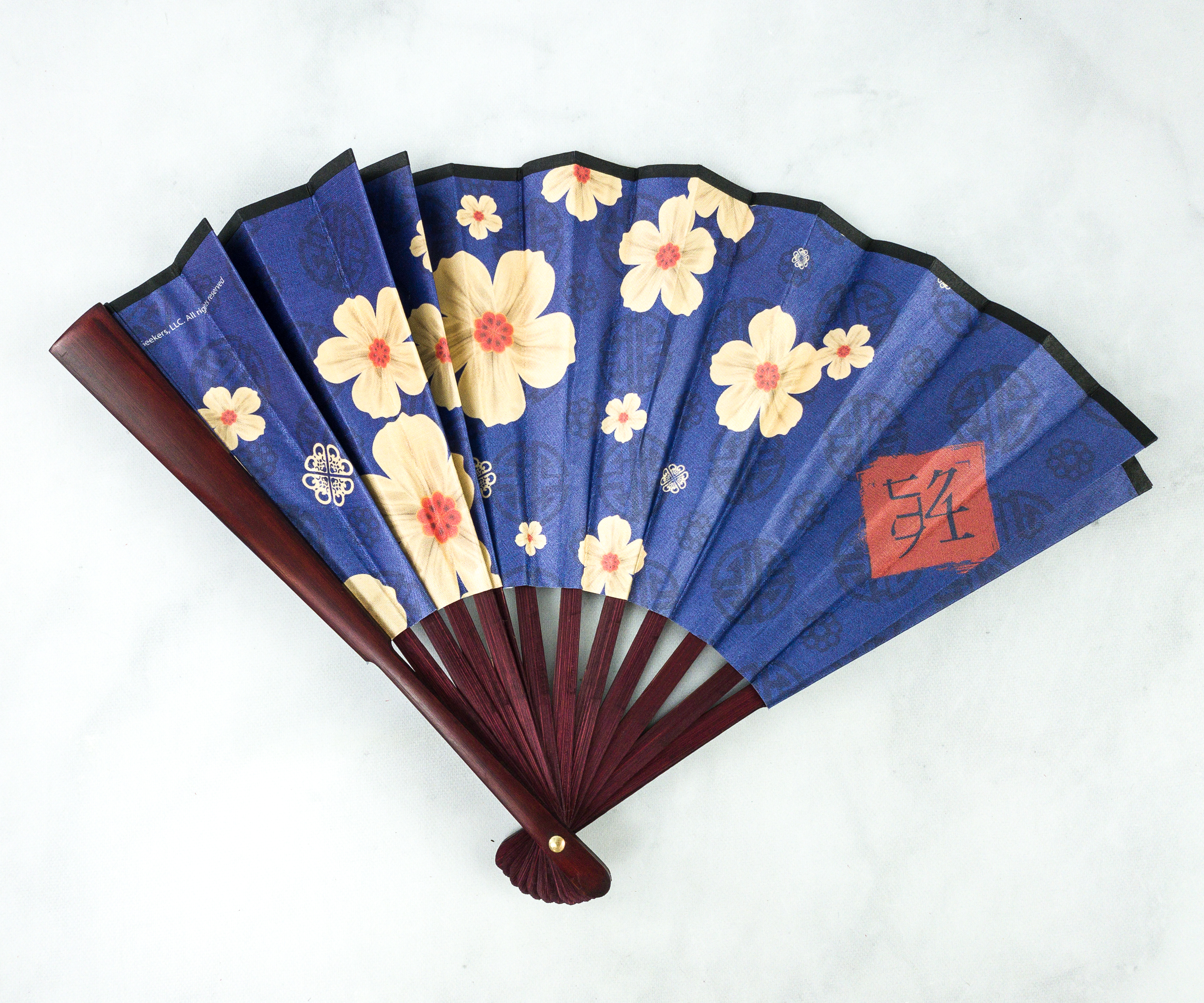
After inspecting the fan, we saw some characters and we used the glossary to translate them!
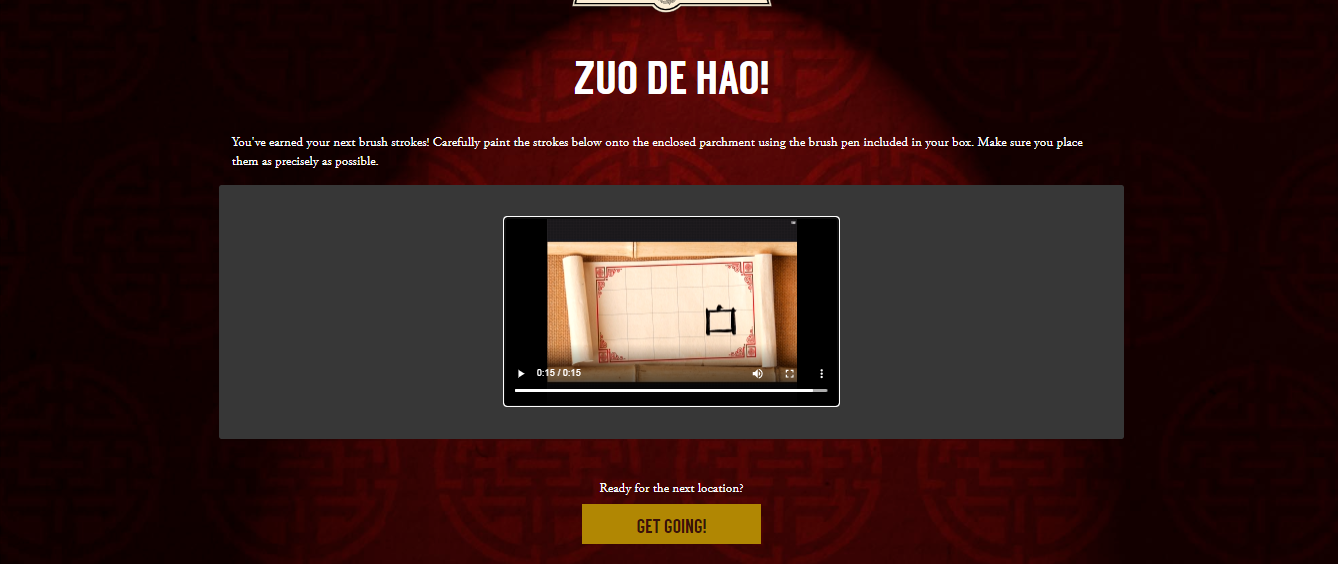
Thanks to the silk fan, we now have the last brush stroke!
We have completed all the brush strokes for our secret phrase!
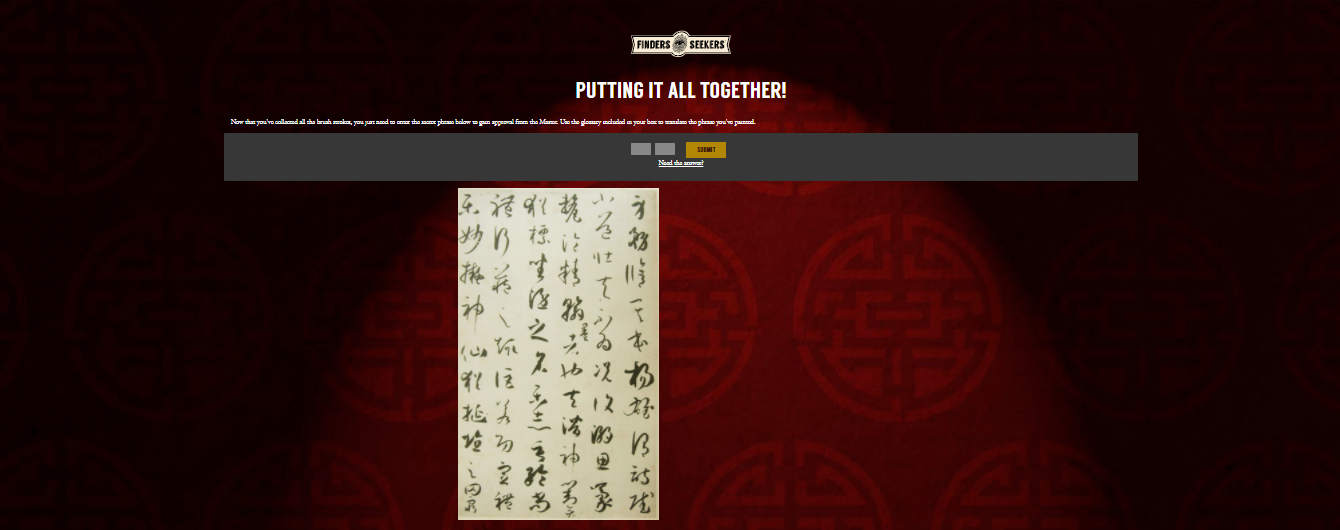
Now that you’ve collected all the brush strokes, you just need to enter the secret phrase below to gain approval from the Master. Use the glossary included in your box to translate the phrase you’ve painted.
It took us a few hours to complete all the strokes and we finally figured out the final word, still with the help of the glossary!
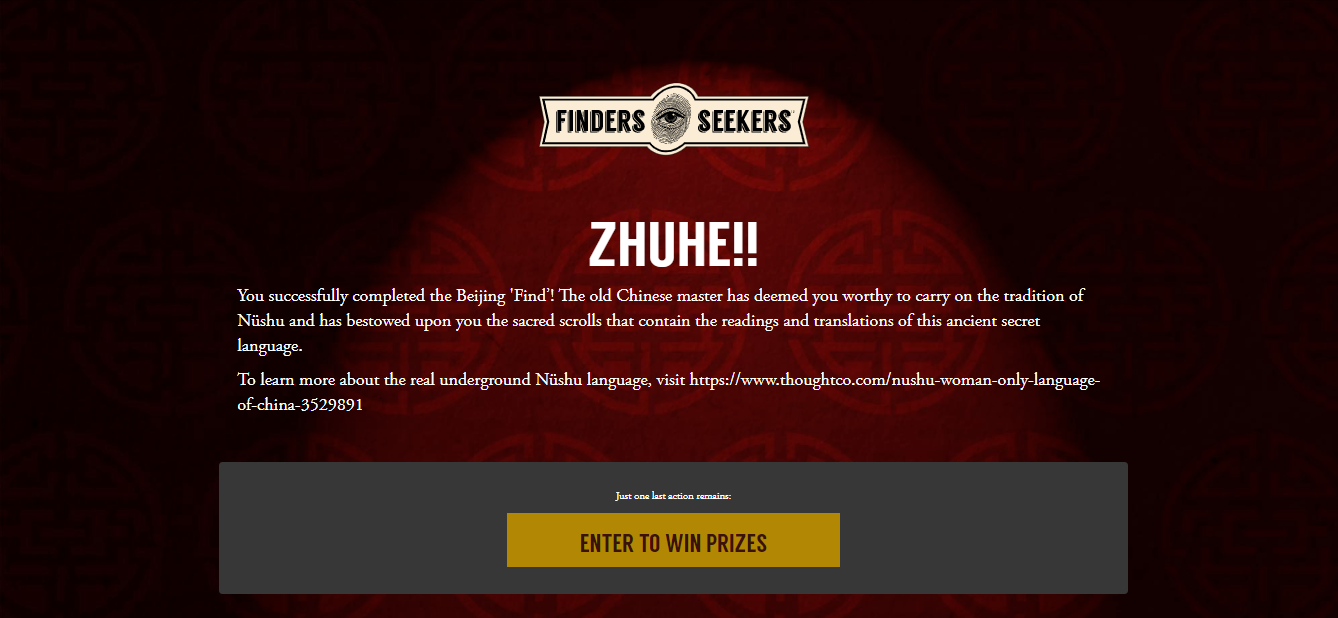
We’re done! By clicking “Enter To Win Prizes,” we can get our price by providing information on the form.
You successfully completed the Beijing ‘Find’! The old Chinese master has deemed you worthy to carry on the tradition of Nüshu and has bestowed upon you the sacred scrolls that contain the readings and translations of this ancient secret language.
This Beijing Box gave us a tour of China with every puzzle we encountered. Discussing its rich culture and history made every task more interesting! The whole family got involved and we learned a lot of things as we progressed. This subscription is perfect for family or friends loving solving puzzles. It’s a nice bonding experience and it’s something we can use especially now that we’re mostly at home!
Did you solve the mystery? How long did it take you? Let us know in the comments below!
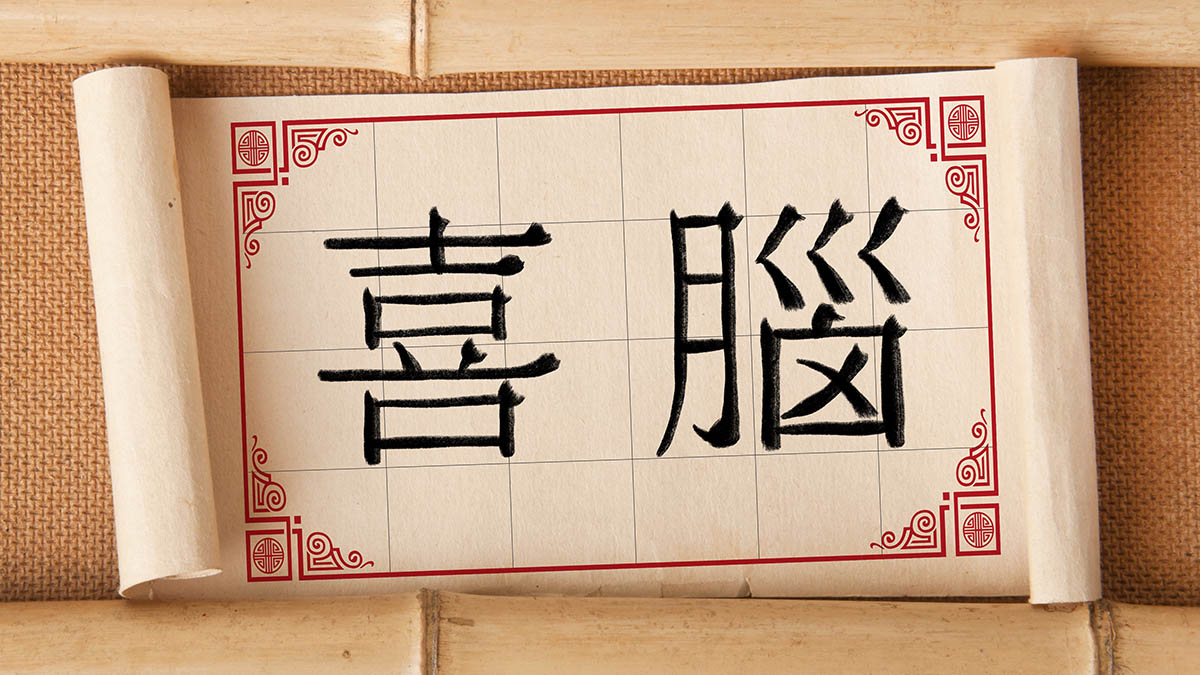




Comments